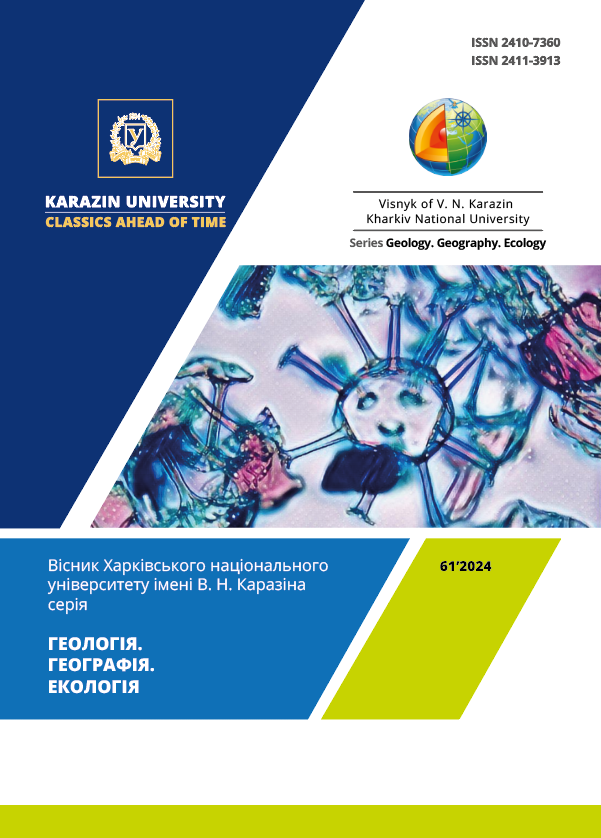Factors and processes of natural environment contamination with substitute waters and petroleum products
Abstract
Statement of the problem determine the factors and processes of contamination of the natural environment with secondary stratum waters.
The subject of the research is associated reservoir waters of oil and gas wells.
The object of the study is the physical and chemical features of associated reservoir solutions containing hydrocarbons and the processes of their influence on natural ecological systems.
The relevance of the research topic is determined by the danger of accompanying reservoir waters and oil products for natural ecological systems and human health. Factors and processes of pollution of the natural environment due to leaks of associated formation water (SW) and oil products in the process of search, exploration and exploitation of hydrocarbon deposits are considered. The mechanisms and ecological consequences of this phenomenon, as well as the level of danger of individual pollutant components, were analyzed. Changes in natural ecosystems as a result of the arrival of sewage sludge and petroleum products into them were studied. Measures to protect the natural environment and reduce environmental risks during drilling of oil and gas wells and development of hydrocarbon deposits are proposed. Accompanying formation waters are brines of sodium chloride solutions (brines) formed at great depths and characterized by high pressures. In the process of drilling deep wells and extracting oil and gas, sewage sludge can gush out onto the earth's surface. This leads to salinization of soils and withdrawal of large areas of agricultural land from circulation, pollution of local water intakes, disruption of the vital activity of flora and fauna, and most importantly – to a negative effect on the human body. It is proposed to divide the types of pollution of sewage containing petroleum products into 4 groups: sodium chloride solutions; petroleum products; toxic components of sewage sludge and petroleum products; thermal pollution by thermal SW.
Results. The factors of natural protection of underground water from pollution have been determined. Intensive water exchange in the infiltration zone leads to both rapid pollution and rapid purification of groundwater and non-pressurized groundwater. Underground waters that lie deeper, due to hydrodynamic pressures, push pollutants out of aquifers and remain clean. The chemical elements and compounds of hazardous waste and oil products belonging to the first, second and third classes of danger are given. The consequences of their negative impact on the human body are indicated. A conclusion was made about the need for environmental monitoring near oil and gas industries. The environmental and economic expediency of using SW as a hydro-mineral raw material for the industrial extraction of valuable chemical elements from them is emphasized.
Downloads
References
Boyko V. S. (2004). Development and exploitation of oil fields. Kyiv: Real-Print, 693.
Gavanyuk N. R. (2006). Mechanism of action of mineralized (formation) water on agricultural plants. Collection: Symbol of the tree in world culture and artistic creation: Scientific Bulletin, 16.4, 178–186.
Dyadin D. V. (2017). Hydrochemical indicators of groundwater pollution centers in the fields of the Eastern oil and gas basin. Environmental safety and balanced resource use, 1(15), 3–47.
Kolodiy V. V., Kolodiy I. V., Mayevsky B. Y. (2009). Oil and gas hydrogeology. Textbook for universities. Ivano-Frankivsk: Fakel, 184.
Nimets N. M., Brusentseva T. V., Tsapko. N. S. (2020). Comprehensive analysis of some models of environmental safety of associated formation waters of oil condensate deposits. Bulletin of NEU, "KhPI", 6. 35–41.
Rodovenchyk Ya. V., Gomerya M. D., Rodovenchyk V. M. (2020). New concept of neutralization of mine waters and concentrates in the process of water purification. Bulletin of NTU "Igor Sikorsky Kyiv Polytechnic Institute". Se-ries: chemical engineering, ecology and resource conservation, 1, 43–49.
Suyarko V. G. (1995). Ecology of the underground hydrosphere of Donbass. Kyiv: Znannya, 69.
Suyarko V. G. (2006). Geochemistry of groundwater of the eastern part of the Dnieper-Donetsk aulacogen. Kharkiv: V. N. Karazin KhNU, 225.
Suyarko V. G., Serdyukova O. O. (2010). Features of groundwater contamination in zones of influence of oil and gas industries. Visnyk of V. N. Karazin Kharkiv National University, Series "Geology. Geography. Ecology", (294), 222–225.
Suyarko V. G. (2015). Forecasting, search and exploration of hydrocarbon deposits. Textbook for universities. Kharkiv: Folio, 413.
Trotsenko A. V., Drygulych P. G., Pukish A. V. (2010). Research on the impact of oil and slag storage sites on the environment. Environmental safety and rational use of nature, 14(23), 171–177.
Ulytsky О., Dіachenko N., Sokolov, A., & Serdіukova O. (2023). Studies of oil product pollution in the aeration zone by mathematical modelling. Visnyk of V. N. Karazin Kharkiv National University, Series "Geology. Geography. Ecology", (59), 44-54. https://doi.org/10.26565/2410-7360-2023-59-04
Al-Ghouti M. A., Al-Kaubi M. A., Asfaq M. Y., Dana D. A. (2019). Produced water characteristics, treatment and reuse: a review. Journal of Water Process Engineering, 28, 222–239.
Azetsu-Scott K., Yeats P., Wohlgeschaffen G., Dalziel J., Niven S., Lee K. (2007). Precipitation of heavy metals in produced water: influence on contaminate transport and toxicity. Marine Environmental Research, 63(2). 146–167.
Barron M. G., Vivian D. N., Heintz R. A., Yim U. H. (2020). Long-term ecological impacts from oil spills: comparison of Exxon Valdez, Hebel Spirit and Deepwater Horizon. Environmental Science Technology, 54(11), 6456–6467.
Boesch D., Rabalals N. N. (Eds.) (1987). Biological effects of drilling fluids, drill cuttings and produced waters. Long-term Environmental Effects of Offshore Oil and Gas Development, Elsevier Applied Science Publishers, Lon-don, 496-538.
Cartmill J.C. (1970). Flow of a disperse emulsion of crude oil in water though porous media. AAPG Bull., 54, 2438–2447.
Fabota P., Ogun Kunle C., Folarin O., Oladele F. (2016). Heavy metal pollution and ecological geochemistry of soil impacted by activities of oil industry in the Niger Delta, Nigeria. Environmental Earth Sciences, 75(4), 1–9.
Grant A. (2002). Toxicity of sediments from around a North Sea oil platform: are metals or hydrocarbons responsi-ble for ecological impacts? Mar. Environ Res., 95–116.
Zabbey N., Obsson G. J. (2017). Conflicts – Oil and water. Global Challinges, 1(5), 1–10.

This work is licensed under a Creative Commons Attribution 4.0 International License.





